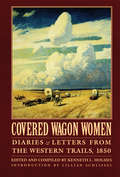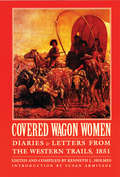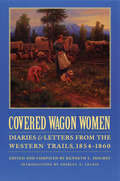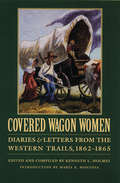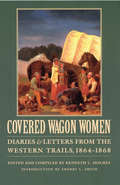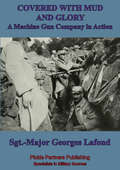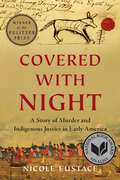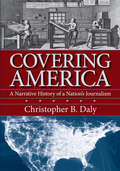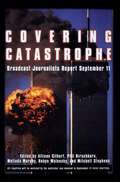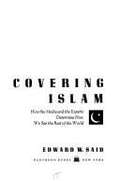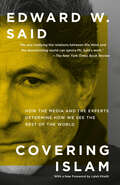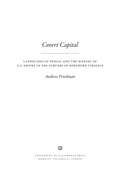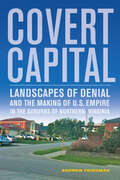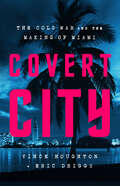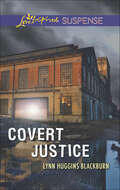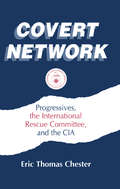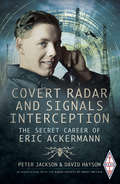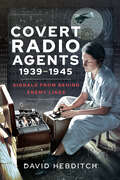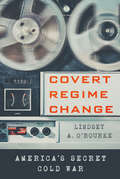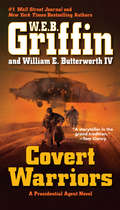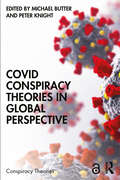- Table View
- List View
Covered Wagon Women, Volume 2: Diaries and Letters from the Western Trails, 1850
by Kenneth L. HolmesThe women who traveled west in covered wagons during the 1840s speak through these letters and diaries. Here are the voices of Tamsen Donner and young Virginia Reed, members of the ill-fated Donner party; Patty Sessions, the Mormon midwife who delivered five babies on the trail between Omaha and Salt Lake City; Rachel Fisher, who buried both her husband and her little girl before reaching Oregon. Still others make themselves heard, starting out from different places and recording details along the way, from the mundane to the soul-shattering and spirit-lifting.
Covered Wagon Women, Volume 3: Diaries and Letters from the Western Trails, 1851
by Kenneth L. Holmes Susan ArmitageThe wagon trains to California greatly decreased in 1851 as reports of deadly cholera on the trail the year before and strikeouts in gold prospecting became known. Those who did go west—about 2,160 men and 1,440 women—tended toward Oregon's rich Willamette Valley because of a new federal land law that awarded a husband and wife a full section. Volume 3 of Covered Wagon Women contains the diaries and letters of six Oregon-bound women, as well as the journal of an English Mormon woman who described her experience all the way from Liverpool to Salt Lake City. The words of these pioneer women convey their exhilaration, courage, exhaustion, and terror in traveling so far into the unknown.
Covered Wagon Women, Volume 4: Diaries and Letters from the Western Trails, 1852: The California Trail
by Kenneth L. HolmesIn 1852 a record number of women helped keep the wagons rolling over the perilous western trails. The fourth volume of Covered Wagon Women is devoted to families headed for California that year. Diaries and letters of six pioneer women describe the rigors en route, trailside celebrations and tragedies, the scourge of cholera, and encounters with the Indians.
Covered Wagon Women, Volume 5: Diaries and Letters from the Western Trails, 1852: The Oregon Trail
by Kenneth L. HolmesAbigail Jane Scott was seventeen when she left Illinois with her family in the spring of 1852. Her record of the journey west is full of expressive detail: breakfasting in a snowstorm, walking behind the wagons to keep warm, tasting buffalo meat, trying to climb Independence Rock. She meets her future husband, Benjamin Duniway, at the end of the Oregon Trail and, in the years to come, finds fame as a writer and a leader of the suffrage movement in the Northwest. Her grandson, David Duniway, edited her trail diary for Covered Wagon Women. This volume includes the equally vivid diaries of other women who rode the wagons in 1852. Polly Coon of Wisconsin recalls trading with the Indians. Martha Read, starting from Illinois, is particularly alert to the suffering of the animals, noting hundreds of dead cows and horses along the way. Cecilia Adams and Parthenia Blank, twin sisters from Illinois, jointly chronicle their once-in-a-lifetime experience.
Covered Wagon Women, Volume 6: Diaries and Letters from the Western Trails, 1853-1854 (Covered Wagon Women Ser. #11)
by Kenneth L. Holmes Ursula Smith Linda Peavy“We traveled this forenoon over the roughest and most desolate piece of ground that was ever made,” wrote Amelia Knight during her 1853 wagon train journey to Oregon. Some of the parties who traveled with Knight were propelled by religious motives. Hannah King, an Englishwoman and Mormon convert, was headed for Salt Lake City. Her cultured, introspective diary touches on the feelings of sensitive people bound together in a stressful undertaking. Celinda Hines and Rachel Taylor were Methodists seeking their new Canaan in Oregon. Also Oregon-bound in 1853 were Sarah (Sally) Perkins, whose minimalist record cuts deep, and Eliza Butler Ground and Margaret Butler Smith, sisters who wrote revealing letters after arriving. Going to California in 1854 were Elizabeth Myrick, who wrote a no-nonsense diary, and the teenage Mary Burrell, whose wit and exuberance prevail.
Covered Wagon Women, Volume 7: Diaries and Letters from the Western Trails, 1854-1860
by Kenneth L. Holmes Shirley Anne LeckieSome of the women traveling west in the late 1850s were strong advocates of equal rights for their sex. On the trail, Julia Archibald Holmes and Hannah Keziah Clapp sensibly wore the “freedom costume” called bloomers. In 1858 Holmes joined the Pikes Peak gold rush and was the first woman of record to climb the famous mountain. Educator Hannah Clapp traveled to California with a revolver by her side, speaking her mind in a letter included in this volume, which is also enriched by the trail diaries of seven other women. Among them were Sarah Sutton, who died in 1854, just before reaching Oregon’s Willamette Valley; Sarah Maria Mousley, a Mormon woman traveling to Utah in 1857; and Martha Missouri Moore, who drove thousands of sheep from Missouri to California with her husband in 1860.
Covered Wagon Women, Volume 8: Diaries and Letters from the Western Trails, 1862-1865
by Kenneth L. Holmes Maria MontoyaThe overland trails in the 1860s witnessed the creation of stage stations to facilitate overland travel. These stations, placed every twenty or thirty miles, ensured that travelers would be able to obtain grain for their livestock and food for themselves. They also sped up the process of mail delivery to remote Western outposts. Tragically, the easing of overland travel coincided with renewed conflicts with the Cheyenne and other Plains Indians. The massacre of Black Kettle’s people at Sand Creek instigated two years of bloody reprisals and counterreprisals. "Amid this turmoil and change, these daring women continued to build on the example set by earlier women pioneers. As Harriet Loughary wrote upon her arrival in California, "[after] two thousands of miles in an ox team, making an average of eighteen miles a day enduring privations and dangers . . . When we think of the earliest pioneers . . . we feel an untold gratitude towards them."
Covered Wagon Women, Volume 9: Diaries and Letters from the Western Trails, 1864-1868
by Kenneth L. Holmes Sherry L. SmithIn their simplicity is their poignancy. On August 7, 1865, Mary Louisa Black noted in her journal that they were “nooning on a nice stream in a valey in the mountains.” A day later she observed that one of the men in the overland expedition had “buried an infant here yesterday—still born.” One can only imagine her emotional turmoil—she had buried her own daughter three months earlier, just as she and her husband set out for Oregon. While each diarist and letter-writer had her personal joys and sorrows, collectively these invaluable accounts demonstrate the passion and courage of these nineteenth-century pioneering women who led and followed their families into the West, pursuing dreams of better economic or social situations. One can only marvel at their ability to persevere under conditions that sent many scurrying back home to the East.
Covered With Mud And Glory: A Machine Gun Company In Action ("Ma Mitrailleuse")
by Anon. Georges Lafond Edwin Gile Rich Georges ClemenceauThe author of this book, SERGEANT-MAJOR GEORGES LAFOND, of the Territorial Hussars, was in South America at the time of mobilization. He returned to France as soon as possible and joined his corps, but asked to be assigned as intelligence officer to the machine-gun sections of the first regiment of Colonial Infantry.With this picked corps, which has been decimated several times, he took part in the engagements in Champagne, on the Somme, at Lihons, Dompierre, Herbècourt, and notably in the days from the first to the fifth of July, where the regiment earned its second citation and received the fourragère.Lafond was discharged after the battles of Maisonnette, and wrote this book of recollections in the hospital at Abbeville, and afterwards at Montpellier, where he had to undergo a severe operation. Sergeant-Major Lafond's narrative makes no claim to literary pretension, but it is simply a collection of actual occurrences. It is a series of short narratives which give the life of a company of machine gunners from the day of its formation to the hour when it was so decimated that it had to be reorganized with men from other corps.
Covered with Glory
by Rod GraggThe battle of Gettysburg was the largest engagement of the Civil War, and--with more than 51,000 casualties--also the deadliest. The highest regimental casualty rate at Gettysburg, an estimated 85 percent, was incurred by the 26th North Carolina Infantry. Who were these North Carolinians? Why were they at Gettysburg? How did they come to suffer such a grievous distinction? In Covered with Glory, award-winning historian Rod Gragg reveals the extraordinary story of the 26th North Carolina in fascinating detail. Praised for its "exhaustive scholarship" and its "highly readable style," Covered with Glory chronicles the 26th's remarkable odyssey from muster near Raleigh to surrender at Appomattox. The central focus of the book, however, is the regiment's critical, tragic role at Gettysburg, where its standoff with the heralded 24th Michigan Infantry on the first day of fighting became one of the battle's most unforgettable stories. Two days later, the 26th's bloodied remnant assaulted the Federal line at Cemetery Ridge and gained additional fame for advancing "farthest to the front" in the Pickett-Pettigrew Charge.
Covered with Night: A Story of Murder and Indigenous Justice in Early America
by Nicole EustaceAn immersive tale of the killing of a Native American man and its far-reaching implications for the definition of justice from early America to today. <p><p>On the eve of a major treaty conference between Iroquois leaders and European colonists in the distant summer of 1722, two white fur traders attacked an Indigenous hunter and left him for dead near Conestoga, Pennsylvania. Though virtually forgotten today, this act of brutality set into motion a remarkable series of criminal investigations and cross-cultural negotiations that challenged the definition of justice in early America. <p><p>In Covered with Night, leading historian Nicole Eustace reconstructs the crime and its aftermath, bringing us into the overlapping worlds of white colonists and Indigenous peoples in this formative period. As she shows, the murder of the Indigenous man set the entire mid-Atlantic on edge, with many believing war was imminent. <p><p>Isolated killings often flared into colonial wars in North America, and colonists now anticipated a vengeful Indigenous uprising. Frantic efforts to resolve the case ignited a dramatic, far-reaching debate between Native American forms of justice—centered on community, forgiveness, and reparations—and an ideology of harsh reprisal, unique to the colonies and based on British law, which called for the killers’ swift execution. <p><p>In charting the far-reaching ramifications of the murder, Covered with Night—a phrase from Iroquois mourning practices—overturns persistent assumptions about “civilized” Europeans and “savage” Native Americans. As Eustace powerfully contends, the colonial obsession with “civility” belied the reality that the Iroquois, far from being the barbarians of the white imagination, acted under a mantle of sophistication and humanity as they tried to make the land- and power-hungry colonials understand their ways. In truth, Eustace reveals, the Iroquois—the Six Nations of the Haudenosaunee, as they are known today—saw the killing as an opportunity to forge stronger bonds with the colonists. They argued for restorative justice and for reconciliation between the two sides, even as they mourned the deceased. <p><p>An absorbing chronicle built around an extraordinary group of characters—from the slain man’s resilient widow to the Indigenous diplomat known as “Captain Civility” to the scheming governor of Pennsylvania—Covered with Night transforms a single event into an unforgettable portrait of early America. A necessary work of historical reclamation, it ultimately revives a lost vision of crime and punishment that reverberates down into our own time.
Covering America: A Narrative History of a Nation's Journalism
by Christopher B. DalyToday many believe that American journalism is in crisis, with traditional sources of news under siege from a failing business model, a resurgence of partisanship, and a growing expectation that all information ought to be free. In Covering America, Christopher B. Daly places the current crisis within a much broader historical context, showing how it is only the latest in a series of transitions that have required journalists to devise new ways of plying their trade. Drawing on original research and synthesizing the latest scholarship, Daly traces the evolution of journalism in America from the early 1700s to the "digital revolution" of today. Analyzing the news business as a business, he identifies five major periods of journalism history, each marked by a different response to the recurrent conflicts that arise when a vital cultural institution is housed in a major private industry. Throughout his narrative history Daly captures the ethos of journalism with engaging anecdotes, biographical portraits of key figures, and illuminating accounts of the coverage of major news events as well as the mundane realities of day-to-day reporting.
Covering Catastrophe
by Allison GilbertCovering Catastrophe tells what it was like for TV and radio journalists to report the most terrifying story of their lives-and our time.
Covering Islam: How the Media and the Experts Determine How We See the Rest of the World
by Edward W. SaidAn unusually sharp look at the way in which the U.S. press and experts have dealt with the crisis in the Middle East and Iran.
Covering Islam: How the Media and the Experts Determine How We See the Rest of the World
by Edward W. SaidIn this classic work, the author of Culture and Imperialism reveals the hidden agendas and distortions of fact that underlie even the most "objective" coverage of the Islamic world."No one stuyding the relations between the West and the decolonizing world can ignore Mr. Said's work." --The New York Times Book ReviewFrom the Iranian hostage crisis through the Gulf War and the bombing of the World Trade Center, the American news media have portrayed "Islam" as a monolithic entity, synonymous with terrorism and religious hysteria. At the same time, Islamic countries use "Islam" to justify unrepresentative and often repressive regimes. Combining political commentary with literary criticism, Covering Islam continues Edward Said's lifelong investigation of the ways in which language not only describes but also defines political reality.
Covert Capital
by Andrew FriedmanThe capital of the U.S. Empire after World War II was not a city. It was an American suburb. In this innovative and timely history, Andrew Friedman chronicles how the CIA and other national security institutions created a U.S. imperial home front in the suburbs of Northern Virginia. In this covert capital, the suburban landscape provided a cover for the workings of U.S. imperial power, which shaped domestic suburban life. The Pentagon and the CIA built two of the largest office buildings in the country there during and after the war that anchored a new imperial culture and social world. As the U.S. expanded its power abroad by developing roads, embassies, and villages, its subjects also arrived in the covert capital as real estate agents, homeowners, builders, and landscapers who constructed spaces and living monuments that both nurtured and critiqued postwar U.S. foreign policy. Tracing the relationships among American agents and the migrants from Vietnam, El Salvador, Iran, and elsewhere who settled in the southwestern suburbs of D.C., Friedman tells the story of a place that recasts ideas about U.S. immigration, citizenship, nationalism, global interconnection, and ethical responsibility from the post-WW2 period to the present. Opening a new window onto the intertwined history of the American suburbs and U.S. foreign policy, Covert Capital will also give readers a broad interdisciplinary and often surprising understanding of how U.S. domestic and global histories intersect in many contexts and at many scales.American Crossroads, 37
Covert Capital: Landscapes of Denial and the Making of U.S. Empire in the Suburbs of Northern Virginia (American Crossroads)
by Andrew FriedmanThe capital of the U.S. Empire after World War II was not a city. It was an American suburb. In this innovative and timely history, Andrew Friedman chronicles how the CIA and other national security institutions created a U.S. imperial home front in the suburbs of Northern Virginia. In this covert capital, the suburban landscape provided a cover for the workings of U.S. imperial power, which shaped domestic suburban life. The Pentagon and the CIA built two of the largest office buildings in the country there during and after the war that anchored a new imperial culture and social world. As the U.S. expanded its power abroad by developing roads, embassies, and villages, its subjects also arrived in the covert capital as real estate agents, homeowners, builders, and landscapers who constructed spaces and living monuments that both nurtured and critiqued postwar U.S. foreign policy. Tracing the relationships among American agents and the migrants from Vietnam, El Salvador, Iran, and elsewhere who settled in the southwestern suburbs of D.C., Friedman tells the story of a place that recasts ideas about U.S. immigration, citizenship, nationalism, global interconnection, and ethical responsibility from the post-WW2 period to the present. Opening a new window onto the intertwined history of the American suburbs and U.S. foreign policy, Covert Capital will also give readers a broad interdisciplinary and often surprising understanding of how U.S. domestic and global histories intersect in many contexts and at many scales.American Crossroads, 37
Covert City: The Cold War and the Making of Miami
by Vince Houghton Eric DriggsSecret operations, corruption, crime, and a city teeming with spies: why Miami was as crucial to winning the Cold War as Washington DC or Moscow. The Cuban Missile Crisis was perhaps the most dramatic and dangerous period of the Cold War. What's less well known is that the city of Miami, mere miles away, was a pivotal, though less well known, part of Cold War history. With its population of Communist exiles from Cuba, its strategic value for military operations, and its lax business laws, Miami was an ideal environment for espionage.Covert City tells the history of how the entire city of Miami was constructed in the image of the US-Cuba rivalry. From the Bay of Pigs invasion to the death of Fidel Castro, the book shows how Miami is a hub for money and cocaine but also secrets and ideologies. Cuban exiles built criminal and political organizations in the city, leading Washington to set up a CIA station there, codenamed JMWAVE. It monitored gang activities, plotted secret operations against Castro, and became a base for surveilling Latin American neighbors. The money and infrastructure built for the CIA was integral to the development of Miami.Covert City is a sweeping and entertaining history, full of stunning experimental operations and colorful characters--a story of a place like no other.
Covert Justice
by Lynn Huggins BlackburnAGENT UNDERCOVER When a woman drags Blake Harrison out of his wrecked car, he knows the mysterious stranger has saved his life. But more shocking than the hit-and-run is the news that a crime cartel has infiltrated his factory. There's a fortune to be made by tampering with the factory's products...but only if Blake is out of the way. Undercover FBI agent Heidi Zimmerman has two goals-catch the criminals in the act, and keep Blake alive. Falling for the single dad and his adorable daughter isn't in the plan. But everything changes when an abduction leaves Heidi face-to-face with a killer, revealing the danger that's been hiding in plain sight all along...
Covert Network: Progressives, the International Rescue Committee and the CIA
by Eric Thomas ChesterThis book tells the story of the International Rescue Committee (IRC), the largest nonsectarian refugee relief agency in the world. Founded in the 1930s by socialist militants, the IRC attracted the support of renowned progressives such as Eleanor Roosevelt, Norman Thomas, and Reinhold Niebuhr. But by the 1950s it had been absorbed into the American foreign policy establishment. Throughout the Cold War, the IRC was deeply involved in the volatile confrontations between the two superpowers and participated in an array of sensitive clandestine operations. The IRC thus evolved from a small organization of committed activists to a global operation functioning as one link in the CIA's covert network.
Covert Radar and Signals Interception: The Secret Career of Eric Ackermann
by Peter Jackson David Haysom“A remarkable reconstruction of the extensive and quite exceptional career” of a key WW2 military intelligence officer. (Royal Air Force Historical Society)Of German stock dating back to 1530 in Saxony, Eric George Ackermann GM was born on the Isle of Wight in 1919 and became a leading figure in the world of signals and electronic intelligence. As a Junior Scientific Officer at the Telecommunication Research Establishment, Boscombe Down, with an honorary commission in the Royal Air Force, he made numerous flights over occupied territory searching for, monitoring and destroying Germany’s Wuerzburg, Knickebein and X Band radar systems. Much of his research was passed to the highest levels of wartime government, ensuring that tactical plans could be executed that took full advantage of top secret German intelligence. A host of secret missions to assess the enemy’s radar capabilities were carried out in North Africa, Gibraltar and Italy. This engaging biography explores his operational deployment at the vanguard of tactical intelligence operations during WWII. Winner of the George Medal for conspicuous gallantry, Ackermann also saw conflict up close and personal. After the war, he played a major part in the implementation of a string of listening stations built along the borders of Soviet Bloc countries, which later gleaned a wealth of invaluable post-war intelligence. Further work in aeronautics and satellite construction in the United States followed. Despite Ackermann’s achievements, he has never been the subject of a book-length study until now. Covert Radar and Signals Interception will appeal to aviation enthusiasts, as well as readers curious to gain new insights into twentieth century intelligence practices and their often far-reaching consequences.
Covert Radio Agents, 1939–1945: Signals From Behind Enemy Lines
by David Hebditch“A treasure of a book…An authentic adventure saga [and] a very human story generously seasoned with ingenuity, technology and hardy individualism.” —K9YA TelegraphIncludes photos and mapsClandestine radio operators had one of the most dangerous jobs of World War II. Those in Nazi-occupied Europe for the SOE, MI6, and OSS had a life expectancy of just six weeks. In the Gilbert Islands, the Japanese decapitated seventeen New Zealand coastwatchers.These highly skilled agents’ main tasks were to maintain regular contact with their home base and pass vital intelligence back. As this meticulously researched book reveals, many operators did more than that. Norwegian Odd Starheim hijacked a ship and sailed it to the Shetlands. In the Solomon Islands Jack Read and Paul Mason warned the defenders of Guadalcanal about incoming enemy air raids, giving American fighters a chance to inflict irreversible damage on the Japanese Air Force. In 1944 Arthur Brown was central to Operation Jedburgh’s success delaying the arrival of the SS Das Reich armored division at the Normandy beachheads. The author also explains in layman’s terms the technology of 1940s radios and the ingenious codes used.Most importantly, Covert Radio Agents tells the dramatic human stories of these gallant behind-the-lines radio agents. Who were they? How were they trained? How did they survive against the odds? This is a highly informative and uplifting history of World War II’s unsung heroes.
Covert Regime Change: America's Secret Cold War (Cornell Studies in Security Affairs)
by Lindsey A. O'RourkeStates seldom resort to war to overthrow their adversaries. They are more likely to attempt to covertly change the opposing regime, by assassinating a foreign leader, sponsoring a coup d’état, meddling in a democratic election, or secretly aiding foreign dissident groups.In Covert Regime Change, Lindsey A. O’Rourke shows us how states really act when trying to overthrow another state. She argues that conventional focus on overt cases misses the basic causes of regime change. O’Rourke provides substantive evidence of types of security interests that drive states to intervene. Offensive operations aim to overthrow a current military rival or break up a rival alliance. Preventive operations seek to stop a state from taking certain actions, such as joining a rival alliance, that may make them a future security threat. Hegemonic operations try to maintain a hierarchical relationship between the intervening state and the target government. Despite the prevalence of covert attempts at regime change, most operations fail to remain covert and spark blowback in unanticipated ways.Covert Regime Change assembles an original dataset of all American regime change operations during the Cold War. This fund of information shows the United States was ten times more likely to try covert rather than overt regime change during the Cold War. Her dataset allows O’Rourke to address three foundational questions: What motivates states to attempt foreign regime change? Why do states prefer to conduct these operations covertly rather than overtly? How successful are such missions in achieving their foreign policy goals?
Covert Warriors
by W.E.B. GriffinCharley Castillo and the former members of Presidential Agent's Office of Organizational Analysis are officially "retired. " But that doesn't mean they're out of action... <P><P> At a Mexican roadblock, a US Embassy SUV is stopped at gunpoint, three of its passengers murdered, and a fourth kidnapped. Everything points to the drug cartels, especially when the kidnappers say they will return the hostage if a cartel kingpin is released from US federal prison. But when word gets to Castillo and his group of retired spies and special operators, they have their doubts.<P> They believe that it's a diversion--that the murders and kidnapping were ordered by someone to lure Castillo & Company to their deaths. But even knowing that may not save them. Powerful forces in the US government are arrayed against them as well, and if one side doesn't get them. . . the other side will. .
Covid Conspiracy Theories in Global Perspective (Conspiracy Theories)
by Peter Knight Michael ButterCovid Conspiracy Theories in Global Perspective examines how conspiracy theories and related forms of misinformation and disinformation about the Covid-19 pandemic have circulated widely around the world.Covid conspiracy theories have attracted considerable attention from researchers, journalists, and politicians, not least because conspiracy beliefs have the potential to negatively affect adherence to public health measures. While most of this focus has been on the United States and Western Europe, this collection provides a unique global perspective on the emergence and development of conspiracy theories through a series of case studies. The chapters have been commissioned by recognized experts on area studies and conspiracy theories.The chapters present case studies on how Covid conspiracism has played out (some focused on a single country, others on regions), using a range of methods from a variety of disciplinary perspectives, including history, politics, sociology, anthropology, and psychology. Collectively, the authors reveal that, although there are many narratives that have spread virally, they have been adapted for different uses and take on different meanings in local contexts.This volume makes an important contribution to the rapidly expanding field of academic conspiracy theory studies, as well as being of interest to those working in the media, regulatory agencies, and civil society organizations, who seek to better understand the problem of how and why conspiracy theories spread. The Open Access version of this book, available at www.taylorfrancis.com, has been made available under a Creative Commons Attribution-Non Commercial-No Derivatives 4.0 license.
